Skype: neodalle-travel
Tel: +86 135 7447 2266
E-mail: sales@visitaroundchina.com

History of Wudang Mountain
Construction of the Ancient Building Complex started in the Tang Dynasty (618-907). During the reign of Emperor Taizong , the Five Dragon Ancestral Temple was built on Wudang Mountain. In the Ming Dynasty (1368-1644), about 33 palaces and structures including the Yuxu Palace, the Grand Purple Cloud Palace, the Yuzhen Palace and the Palace of Harmony were built. Then the grand and magnificent building complex was formed. At present, the extant building complex includes the Palace of Harmony, the Grand Purple Cloud Palace, the South Cliff Palace, the Yuzhen Palace, relics of the Yuxu Palace and the Five Dragon Ancestral Temple, Xuanyue Gate (a huge archway) and the Fuzhen Temple.
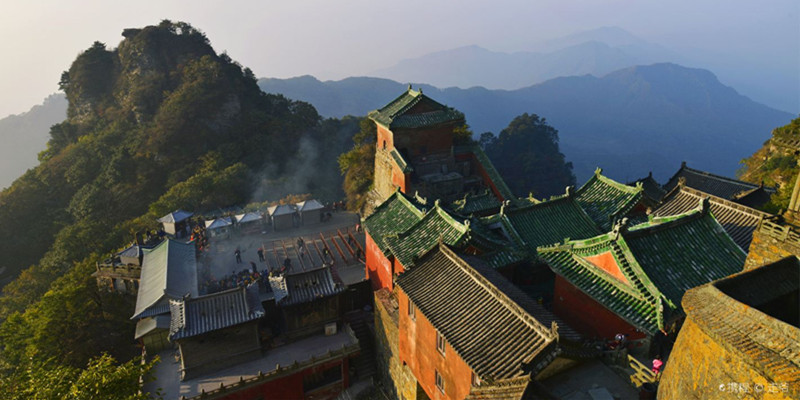
What to see in Wudang Mountain?
Wudang Mountain is deemed World Cultural Heritage, Famous Place of Taoism, and National Key Scenic Spot. It is located within Shiyan City, Hubei Province. The ancient buildings of Mount Wudang are aligned in accordance with the legend of the immortal practice of Zhenwu and were built in accordance with the royal standards of Ming Dynasty. Effects of the buildings are so mysterious and supernatural that people might think that the buildings are made by the gods themselves. Khosla, expert of UN, said that “Mount Wudang is the most beautiful place in the world for it has combined the ancient wisdoms, historical buildings and natural scenes all together.”
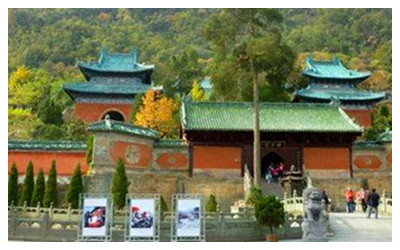 |
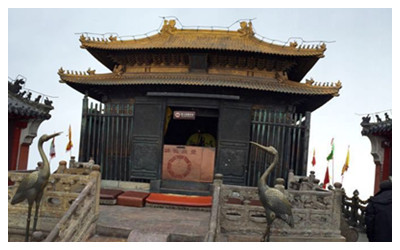 |
| Grand Purple Cloud Palace | Palace of Harmony |
Palace of Harmony
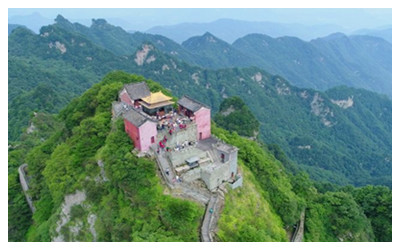 Situated on the south section of Tianzhu Peak, the Palace of Harmony is composed of the Golden Palace (Golden Peak), the Forbidden City and the Gutong Hall. The Golden Palace is the most celebrated. Constructed of bronze, the palace is about four meters (13 feet) long, three meters (10 feet) wide and six meters (20 feet) high. In the hall stands the statue of Emperor Zhenwu in the shrine with Golden Boy and Jade Girl, and two generals of Fire and Water attending him on the left and right. It is said that the statue of Emperor Zhenwu is about ten tons (22,046 pounds). Above the shrine is hung a golden plaque with four Chinese characters 'Jin', 'Guang', 'Miao' and 'Xiang' written by Kangxi, an emperor in the Qing Dynasty (1644-1911). Through the ages, the palace still presents its glamour and grandiosity.
Situated on the south section of Tianzhu Peak, the Palace of Harmony is composed of the Golden Palace (Golden Peak), the Forbidden City and the Gutong Hall. The Golden Palace is the most celebrated. Constructed of bronze, the palace is about four meters (13 feet) long, three meters (10 feet) wide and six meters (20 feet) high. In the hall stands the statue of Emperor Zhenwu in the shrine with Golden Boy and Jade Girl, and two generals of Fire and Water attending him on the left and right. It is said that the statue of Emperor Zhenwu is about ten tons (22,046 pounds). Above the shrine is hung a golden plaque with four Chinese characters 'Jin', 'Guang', 'Miao' and 'Xiang' written by Kangxi, an emperor in the Qing Dynasty (1644-1911). Through the ages, the palace still presents its glamour and grandiosity.
The Golden Temple, located at the top of Tianzhu Peak, the main peak of Wudang Mountain, was built in the 14th year of Yongle in the Ming Dynasty (1416). The roof of the Golden Palace adopts the royal style of double eaves palace, and such a high specification is really rare. It has been six hundred years since the Golden Palace was built, and after several lightning strikes, it still stands tall. The eternal light in the hall is said to have never been extinguished for hundreds of years, even if it was stormy. Many tourists went to the Golden Temple to pay respects to Emperor Zhenwu and pray for blessings.
Grand Purple Cloud Palace
Located below Zhanqi Peak, the Grand Purple Cloud Palace is the most magnificent and best-preserved Taoist building on Wudang Mountain. Covering an area of 6,850 square meters (two acres), the palace consists of the Dragon and Tiger Hall, the Stele Pavilion, the Shifang Hall, the Parents' Hall, the Grand Hall of Purple Cloud Palace and other buildings. Covered with blue glazed tiles and yellow and blue carvings on the roof, the Grand Hall is the most representative wooden structure on the mountain. In the hall is worshipped the sculpture of Emperor Jade which was made by a Ming Dynasty artisan.
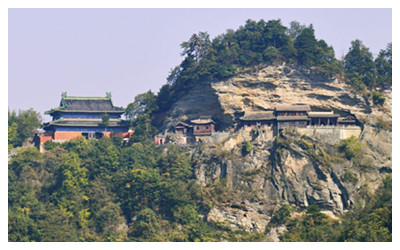 |
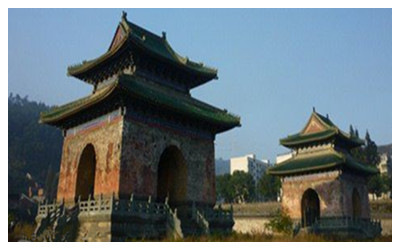 |
| South Cliff Palace | Yuzhen Palace |
South Cliff Palace
The South Cliff Palace is situated below the Duyang Cliff. It has the Tianyi Zhenqing Hall, the Two Bearings Hall, the Eight Diagrams Pavilion, the South Heaven Gate and the Flying Cliff. Built in the Yuan Dynasty (1271-1368), the Tianyi Zhenqing Hall is the most renowned. All the beams, pillars, doors and windows were carved from stone. This stone palace is a masterpiece of Chinese stone carving.
Yuzhen Palace
The Yuzhen Palace, the relics of the Yuxu Palace and the Five Dragon Ancestral Temple, Xuanyue Gate (a huge archway) and the Fuzhen Temple are also must-sees on the mountain. In addition, many sculptures, offerings and sutras in the palaces, tablets and inscriptions on the cliffs are precious relics and worth a visit.
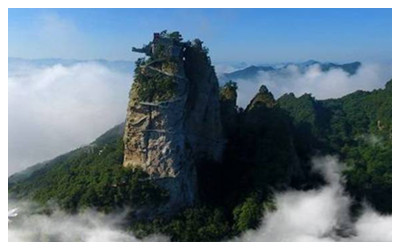 Daming Peak
Daming Peak
The mountain is also celebrated for its appealing natural landscape including 72 peaks, 36 rocks, 24 streams, 11 caves, nine springs and three ponds. At any time of the year, tourists can enjoy its wonderful natural scenery.
Travel Tips
Add: Wudangshan Town, Mudanjiang city,Bubei Province
Opening hours: 08:00-17:30
Entrance Fee: CNY 235
http://www.wudangshan.com/
Tel:0719-5908888,0719-5908829
Transportation:
By air: Tourists can fly to Wudangshan Airport from Xian, Tianjin, Kunming, Wuhan and Hangzhou. Then take a taxi to reach the mountain at a cost of CNY60-80.
By train: Take a train from Beijing, Shanghai, Chongqing, Guangzhou, Nanjing, Qingdao, Wuhan, Xian or some other cities and get off at Wudangshan Station. Transfer to intercity bus no. 203 to the scenic area directly.
By bus:
1. From Shiyan: Intercity bus no. 202 can take visitors from Shiyan Railway Station to the mountain within 70 minutes.
2. From Xian: Two direct tourist buses to the scenic area are scheduled at the Provincial Bus Station opposite Xian Railway Station, leaving at 09:00 and 15:00. It takes around 4 hours.
3. From Wuhan: One direct bus is available from Jinjiadun Bus Station, departing at 13:40 daily. It takes around 6 hours.
 Ask Questions ?
Ask Questions ?